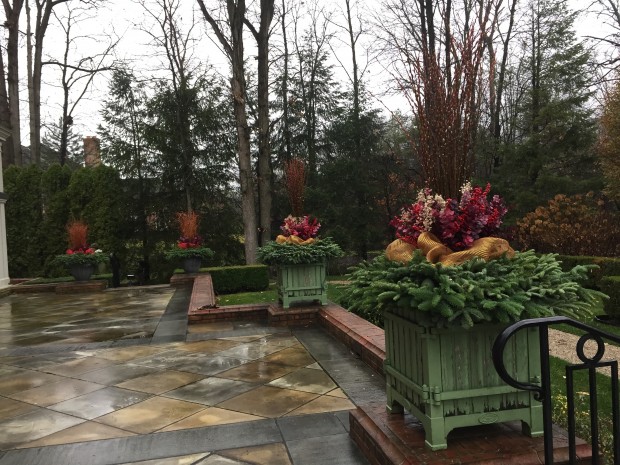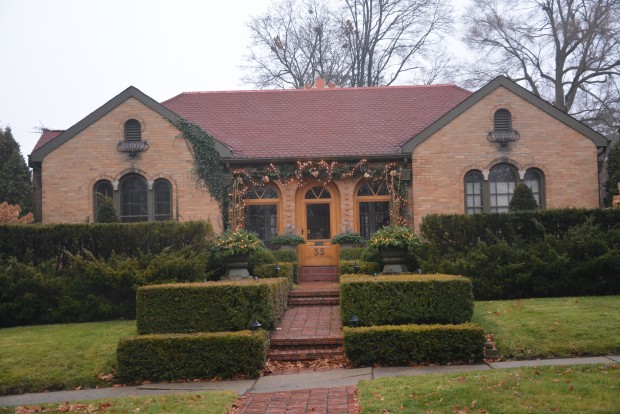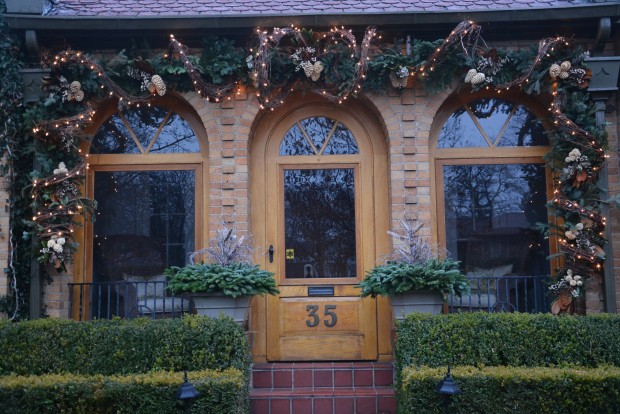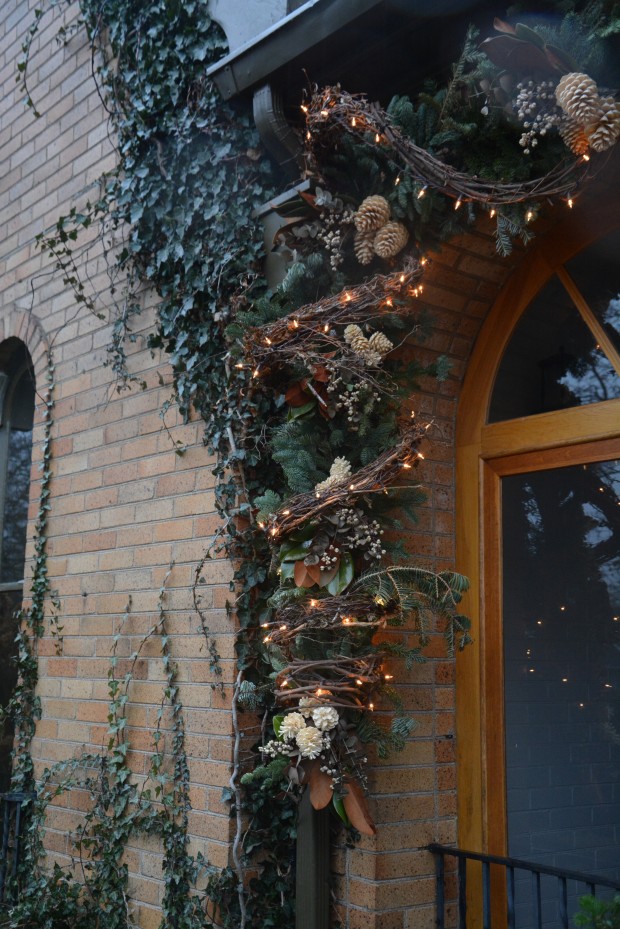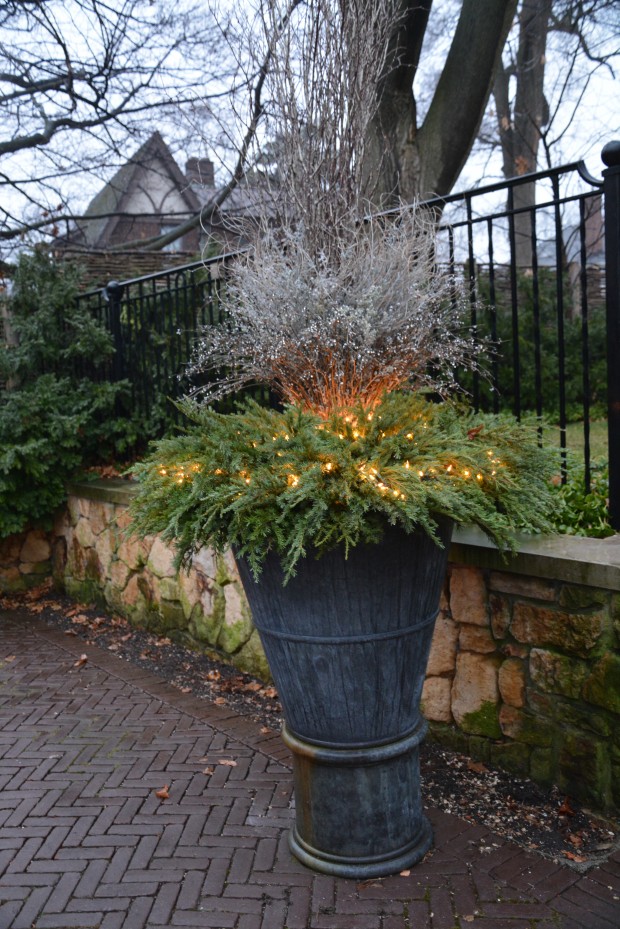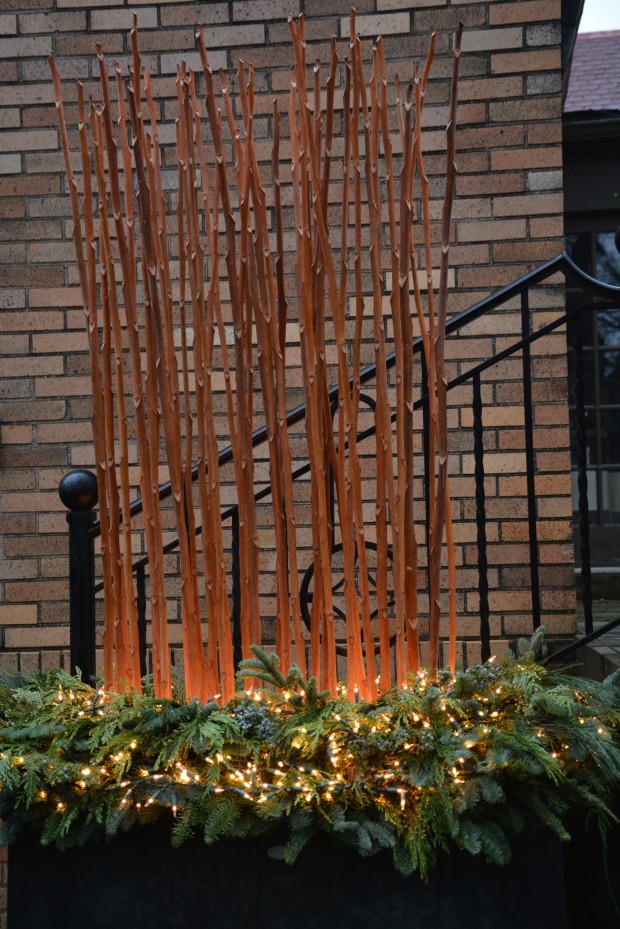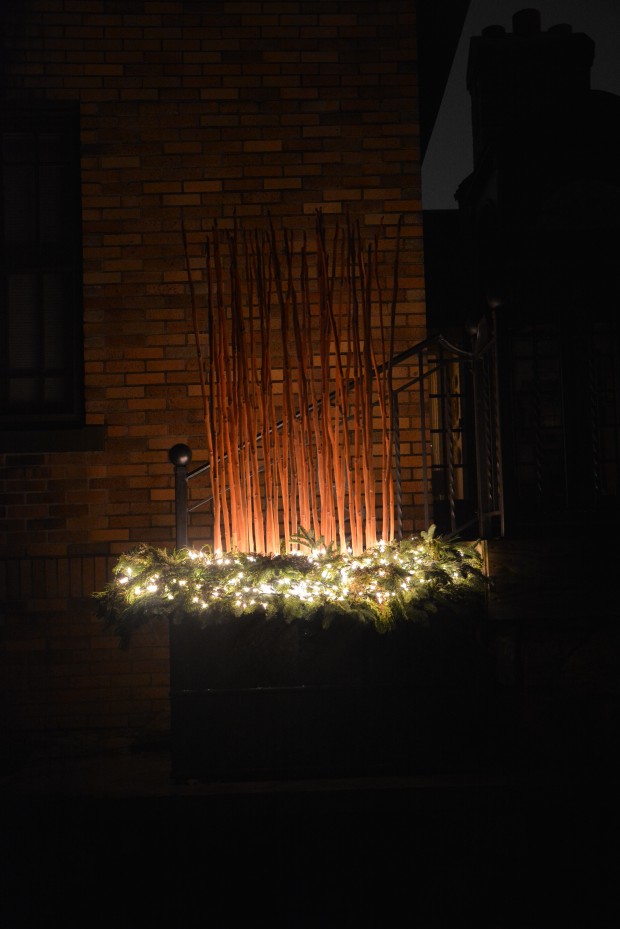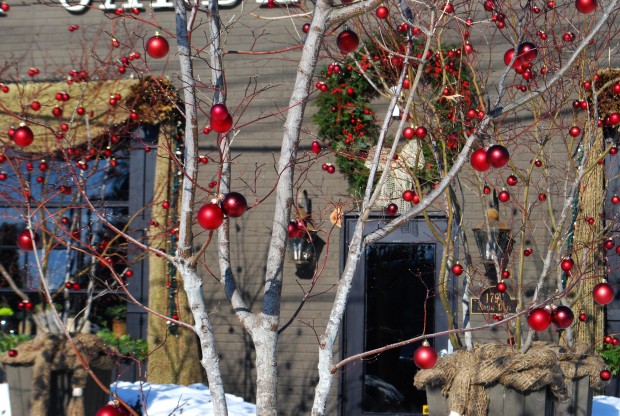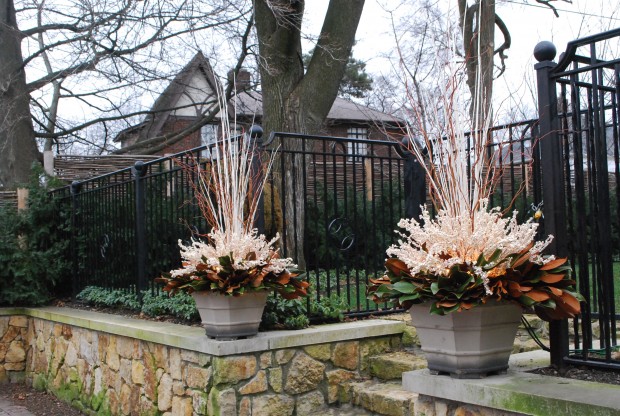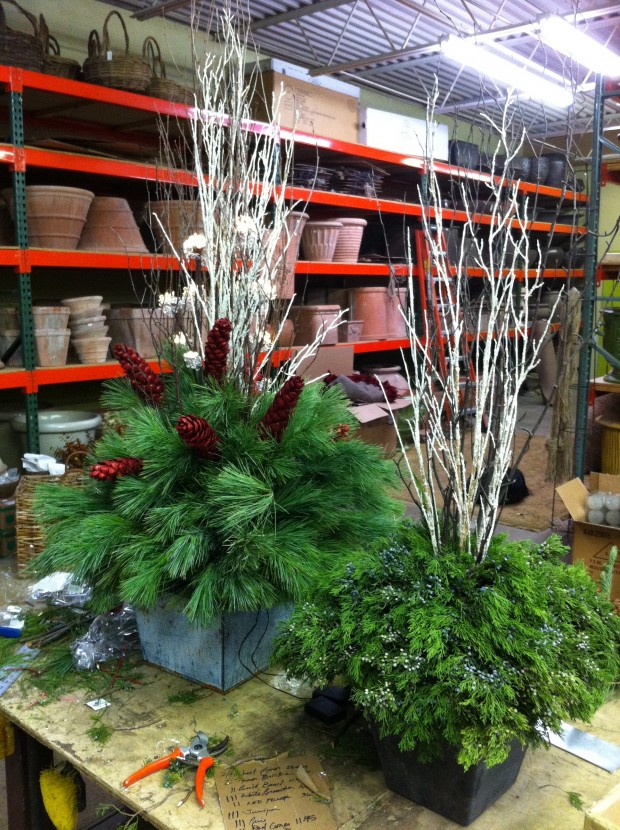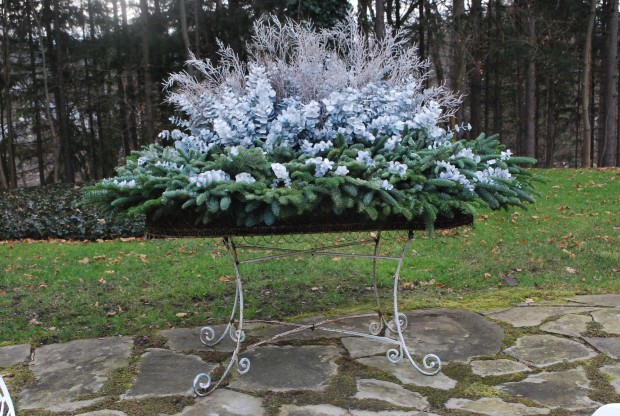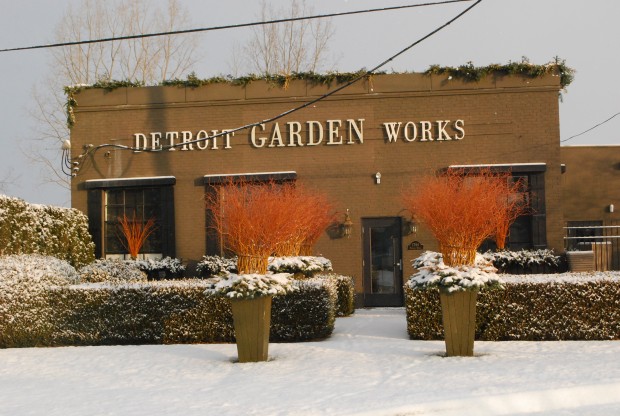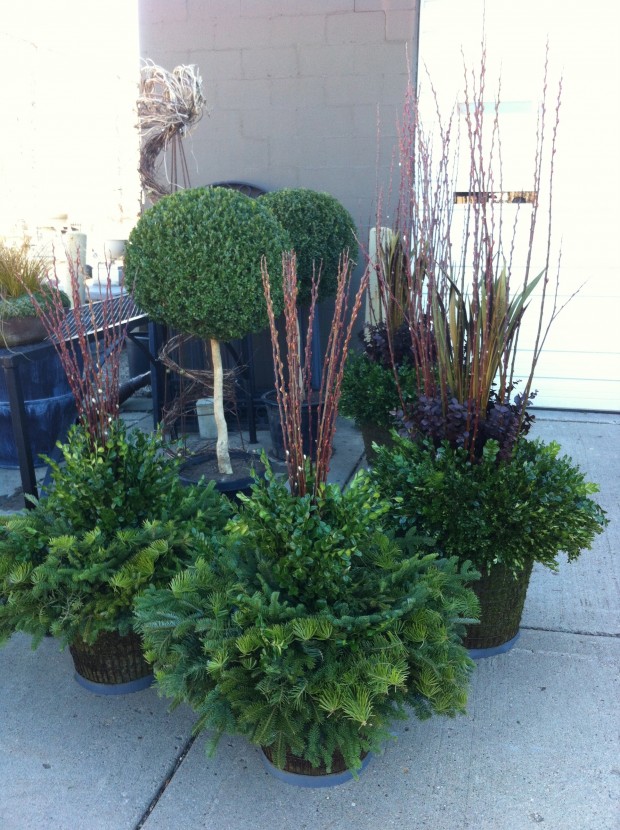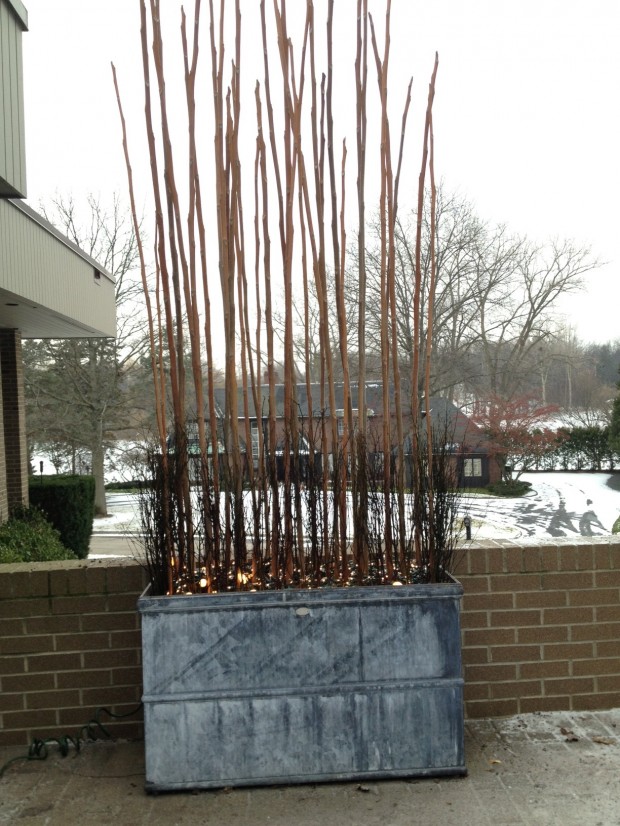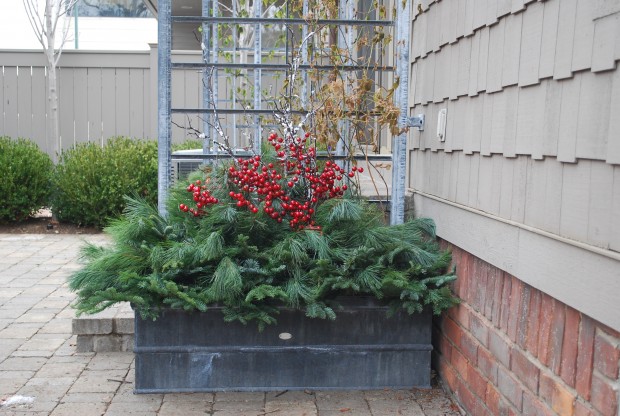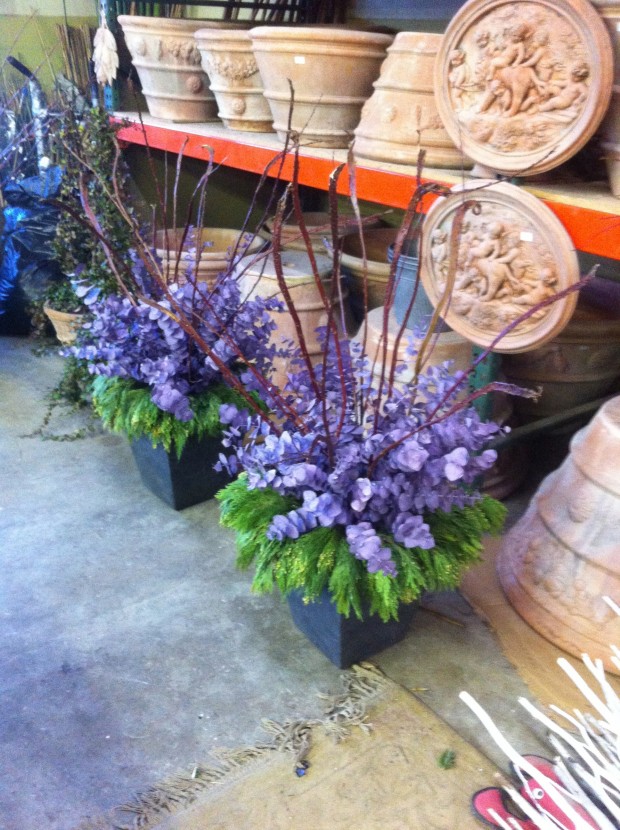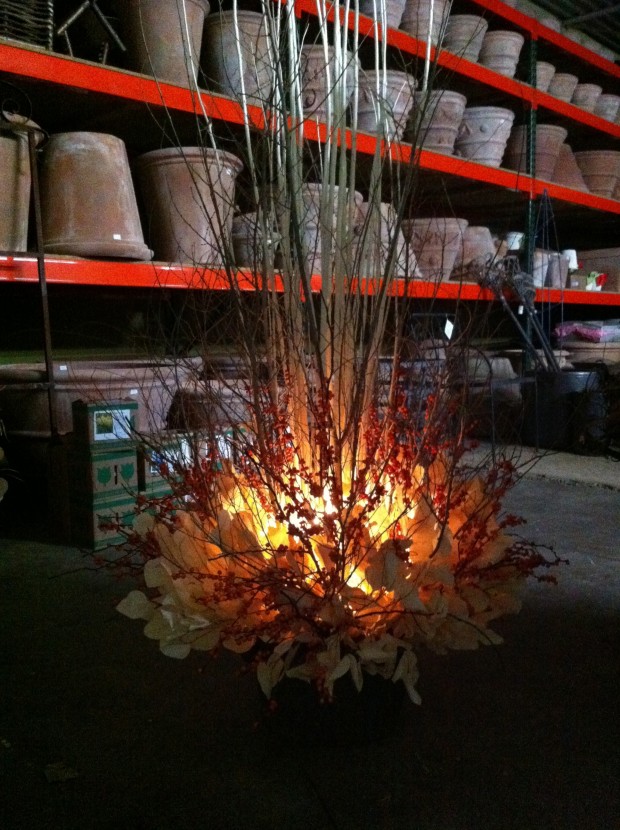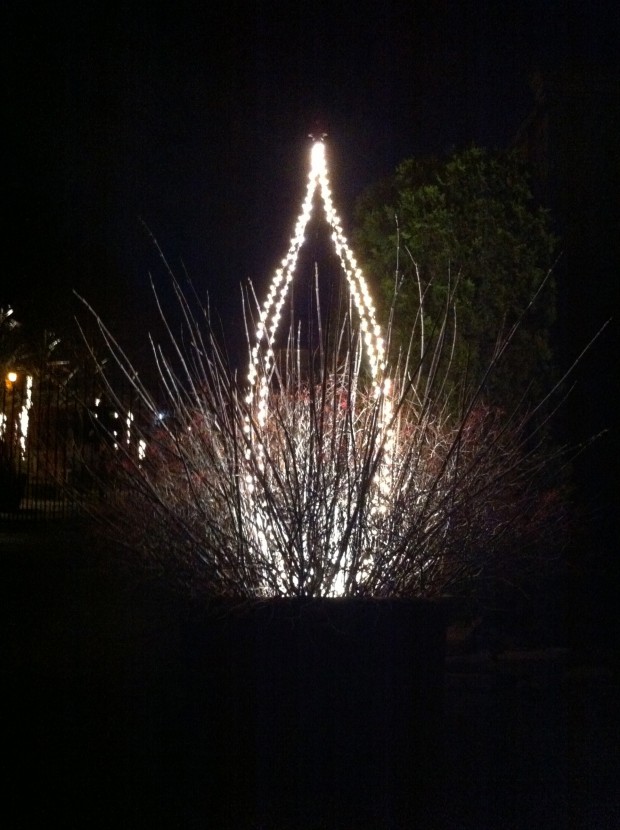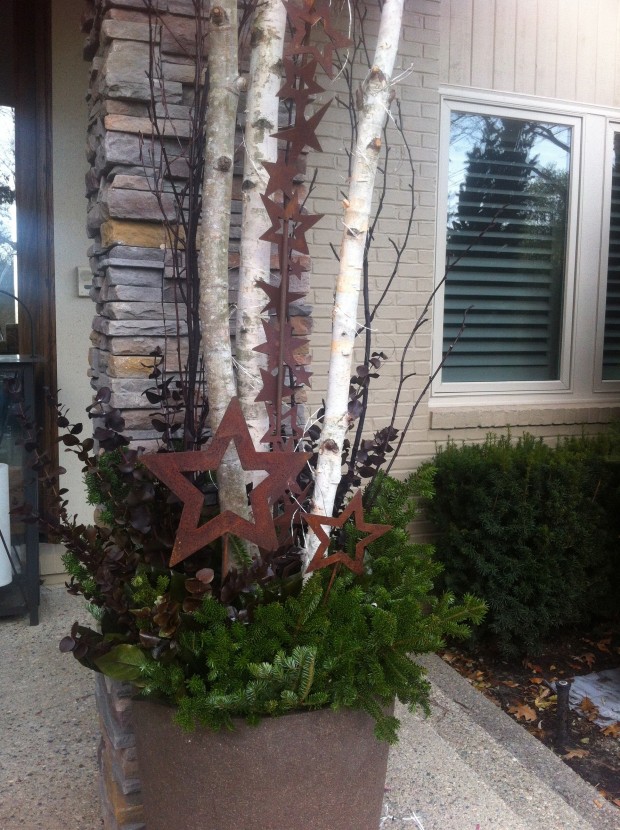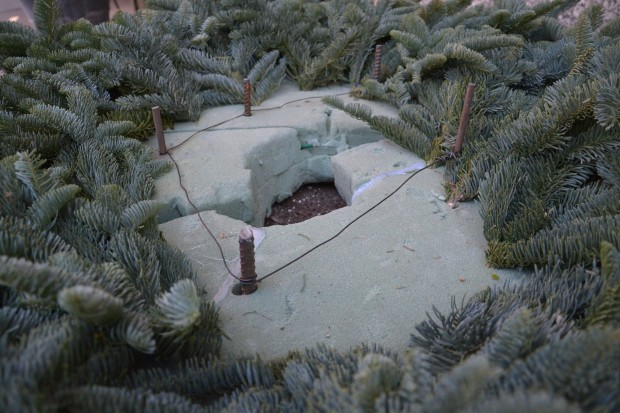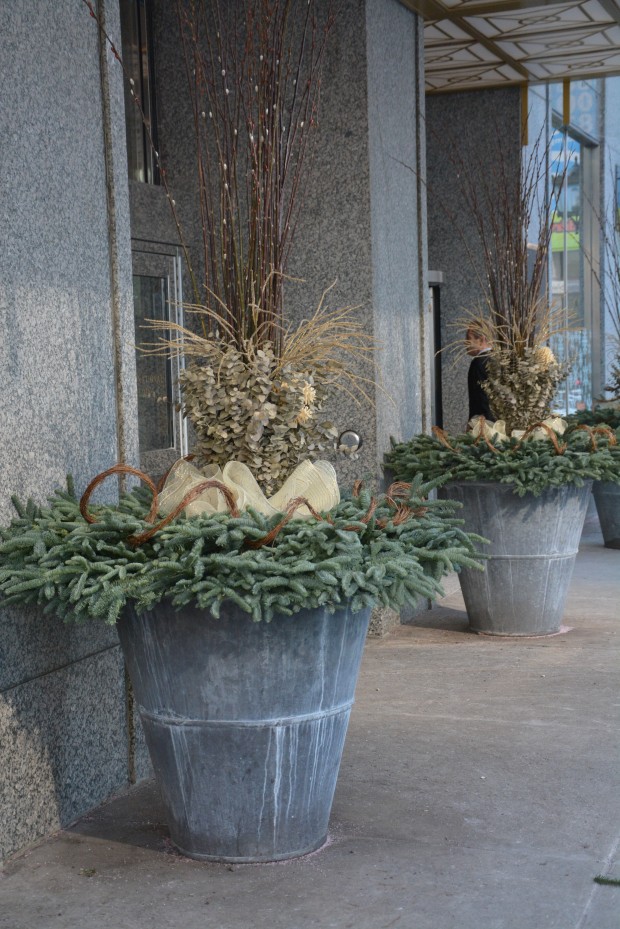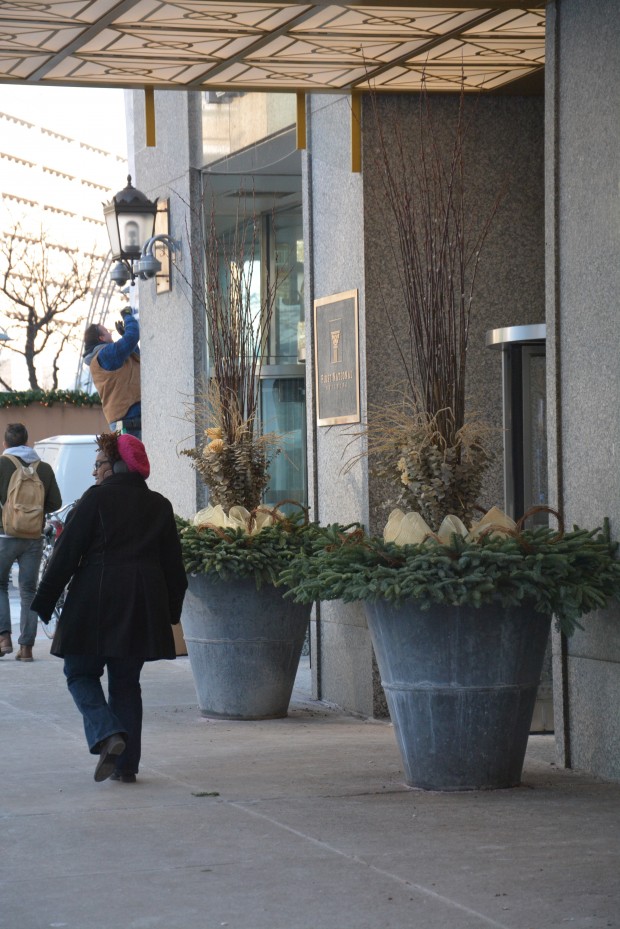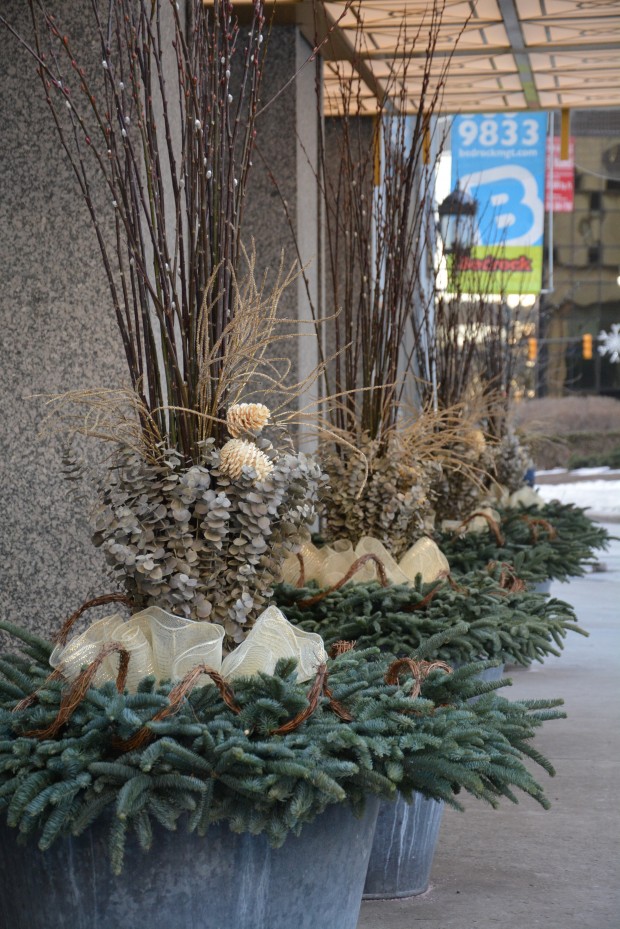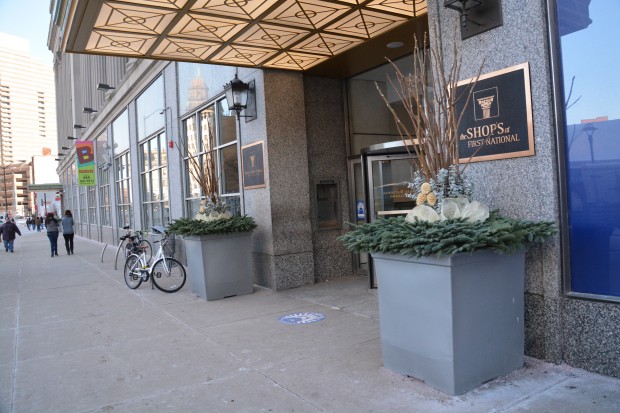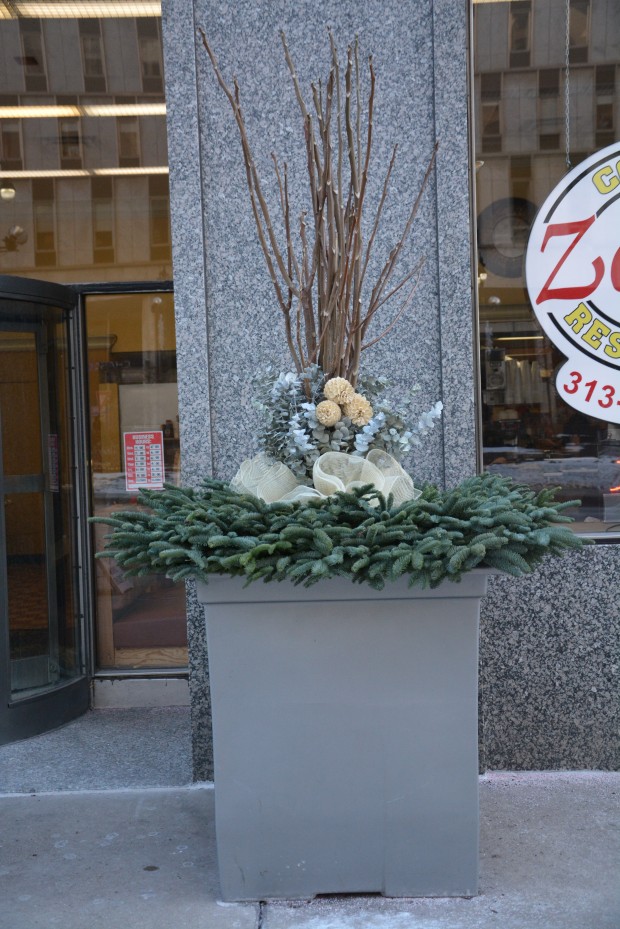 I am always appreciative of how much of the construction of the winter pots we are able to do in the shop, once we get to the installation phase. The greens for this oval bronze container had been stuffed into a form several days ago. We try to be very accurate about the size of those forms, especially given that they will last through at least 3 seasons. Once the centerpiece was set, we attached a collar of red sinamay. Sinamay is a polyester mesh available in various widths. We run a wire through a length of mesh, folded in have, with long running stitches. Once the wire is pulled tight around the centerpiece, it creates a wavy graceful collar that softens the transition from the greens to the centerpiece. Sinamay with a metallic thread is a simple way to say holiday, and is very simple to remove after the holidays. Marzela did all of the finishing touches.
I am always appreciative of how much of the construction of the winter pots we are able to do in the shop, once we get to the installation phase. The greens for this oval bronze container had been stuffed into a form several days ago. We try to be very accurate about the size of those forms, especially given that they will last through at least 3 seasons. Once the centerpiece was set, we attached a collar of red sinamay. Sinamay is a polyester mesh available in various widths. We run a wire through a length of mesh, folded in have, with long running stitches. Once the wire is pulled tight around the centerpiece, it creates a wavy graceful collar that softens the transition from the greens to the centerpiece. Sinamay with a metallic thread is a simple way to say holiday, and is very simple to remove after the holidays. Marzela did all of the finishing touches.
 We did have to shovel the snow out of the pots. Some pots had just the right depth of soil, once the fall plants were removed. Others needed a little topping up.
We did have to shovel the snow out of the pots. Some pots had just the right depth of soil, once the fall plants were removed. Others needed a little topping up.
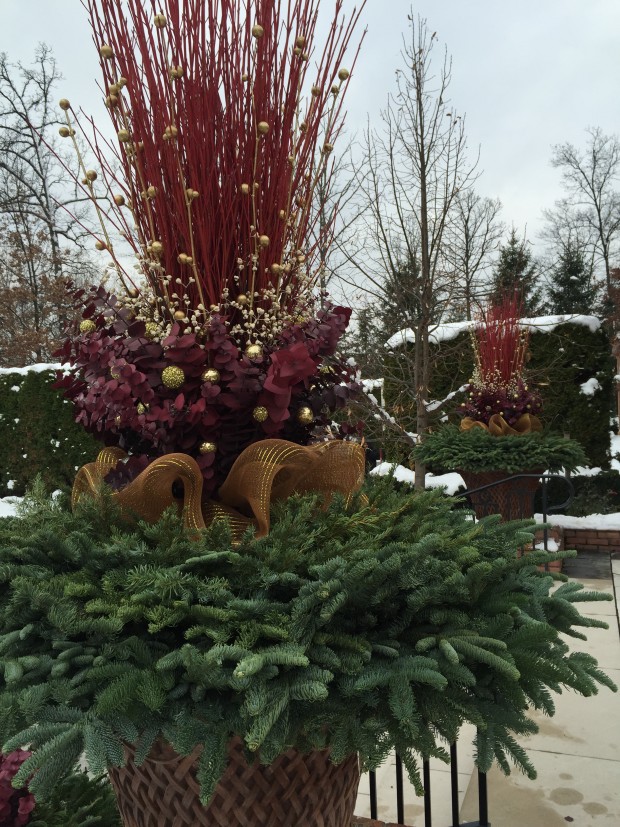 Even though these centerpieces were large, it was a short and simple matter to cut through the foam holding the greens, drive the bamboo stake down into the pot, and add a few greens to the ragged edges. This gold sinamay adds a very festive and absolutely weatherproof holiday note. Sinamay is also known as decor mesh, and it is readily available, should you search for it on your computer.
Even though these centerpieces were large, it was a short and simple matter to cut through the foam holding the greens, drive the bamboo stake down into the pot, and add a few greens to the ragged edges. This gold sinamay adds a very festive and absolutely weatherproof holiday note. Sinamay is also known as decor mesh, and it is readily available, should you search for it on your computer.
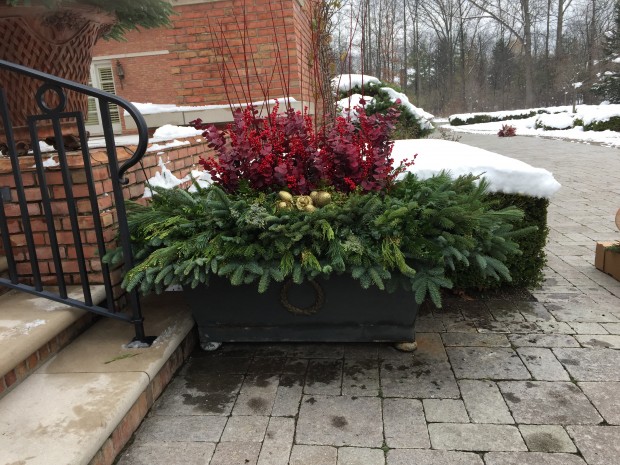 This low rectangular arrangement was finished in its entirety in the shop. We only added 10 stems of red twig to the center, once the installation was complete. This pot is festive and dressy.
This low rectangular arrangement was finished in its entirety in the shop. We only added 10 stems of red twig to the center, once the installation was complete. This pot is festive and dressy.
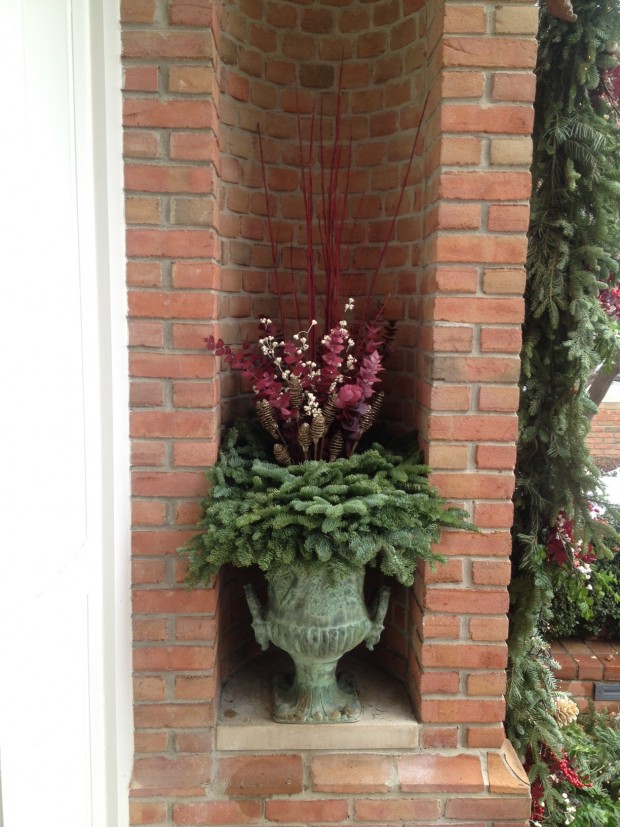 Every pot got filled. If I have a container I do not intend to fill for the winter, I put it away. A container in the landscape that is left empty for the winter is a missed opportunity to garden. I have one very special, sculptural, and old French pot in my landscape that I never plant. That empty pot, and the weather acting on it, has a significance to me that I cannot really explain. Some garden ornament evokes very strong feelings, and that can be enough. But all of these pots needed filling. A winter life for a garden and its head gardener can be a good life.
Every pot got filled. If I have a container I do not intend to fill for the winter, I put it away. A container in the landscape that is left empty for the winter is a missed opportunity to garden. I have one very special, sculptural, and old French pot in my landscape that I never plant. That empty pot, and the weather acting on it, has a significance to me that I cannot really explain. Some garden ornament evokes very strong feelings, and that can be enough. But all of these pots needed filling. A winter life for a garden and its head gardener can be a good life.
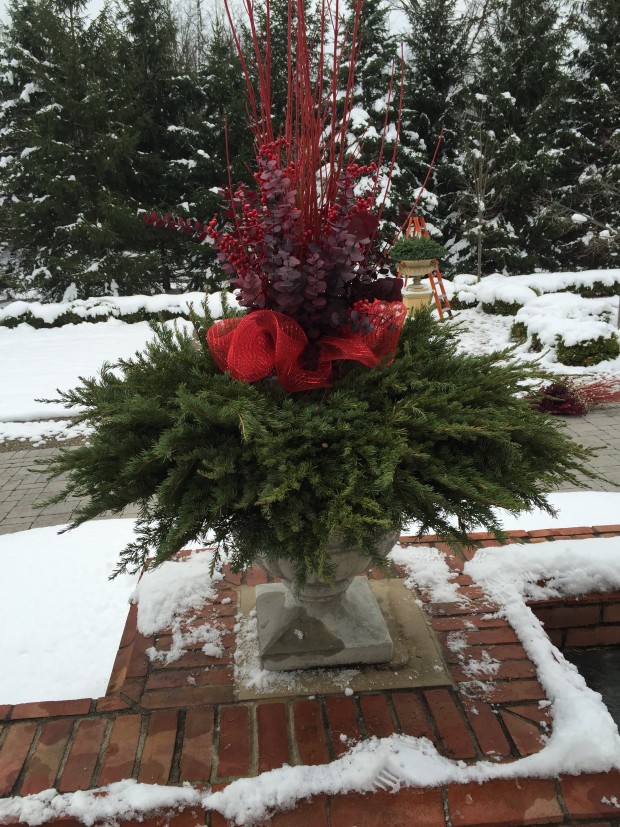 These concrete urns needed to be filled for the winter. They are not especially fine pots, but there are six of them, and they punctuate a long terrace. What we have in them is simple. Of particular interest is the choice of greens. Mountain hemlock branches are harvested from trees at very high elevations. We have to take these greens early in the season. I could not order them now. These trees are up high, and buried in snow by now. They are perfect for containers in exposed and windy locations. Even in cut form, they will stay green until the end of March.
These concrete urns needed to be filled for the winter. They are not especially fine pots, but there are six of them, and they punctuate a long terrace. What we have in them is simple. Of particular interest is the choice of greens. Mountain hemlock branches are harvested from trees at very high elevations. We have to take these greens early in the season. I could not order them now. These trees are up high, and buried in snow by now. They are perfect for containers in exposed and windy locations. Even in cut form, they will stay green until the end of March.
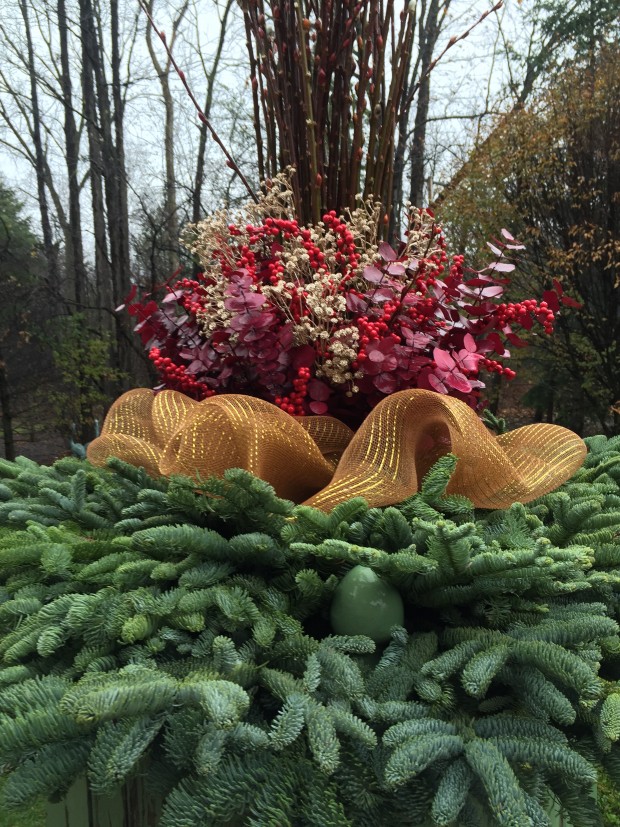 The pots and boxes in the back yard got installed today in fairly steady rain. Our high temperature today was 58 degrees-I will take that, and shrug off the rain.
The pots and boxes in the back yard got installed today in fairly steady rain. Our high temperature today was 58 degrees-I will take that, and shrug off the rain.
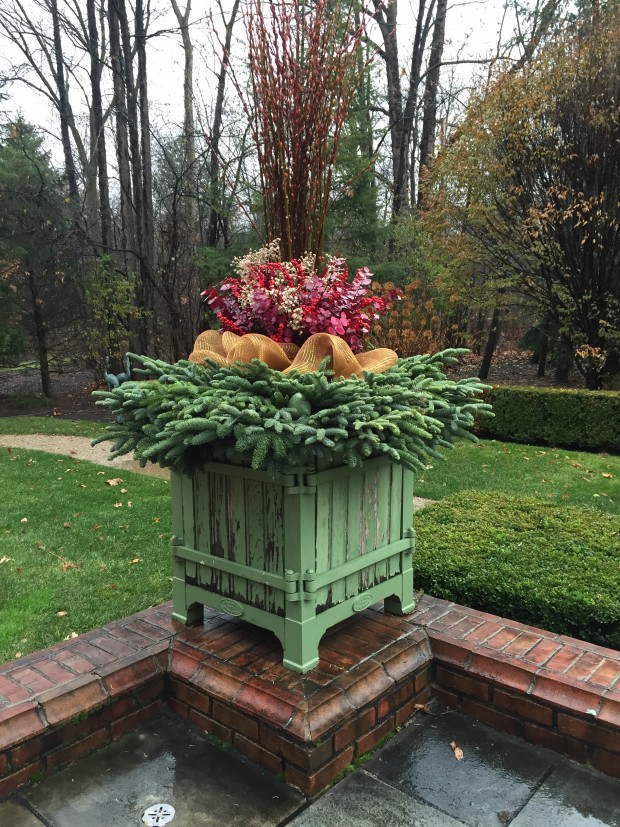 This client bought these French made orangery boxes from me in 2003. The oval medallion at the bottom of each side of the box details the year of manufacture. These French boxes, the history of the manufacture of which dates back hundreds of years, are very dear to my heart. There are no other garden boxes quite like them. They are as beautiful a box as ever graced a landscape. They inspired me to open Branch. Though the oak and cast iron fittings are as solid as they can be, the paint has deteriorated. Weather takes its toll. We will restore them, at the end of the winter.
This client bought these French made orangery boxes from me in 2003. The oval medallion at the bottom of each side of the box details the year of manufacture. These French boxes, the history of the manufacture of which dates back hundreds of years, are very dear to my heart. There are no other garden boxes quite like them. They are as beautiful a box as ever graced a landscape. They inspired me to open Branch. Though the oak and cast iron fittings are as solid as they can be, the paint has deteriorated. Weather takes its toll. We will restore them, at the end of the winter.
 There is not so much more to say about this installation, except that once a container arrangement comes out of the shop, and finds a home in the landscape, it is easy to see what they provide is like no other element. If you are a gardener, I would encourage you to add some pots to your landscape and garden. They are a challenge and a delight, year round.
There is not so much more to say about this installation, except that once a container arrangement comes out of the shop, and finds a home in the landscape, it is easy to see what they provide is like no other element. If you are a gardener, I would encourage you to add some pots to your landscape and garden. They are a challenge and a delight, year round.
 Landscapes with multiple levels of interest sustain the eye.
Landscapes with multiple levels of interest sustain the eye.
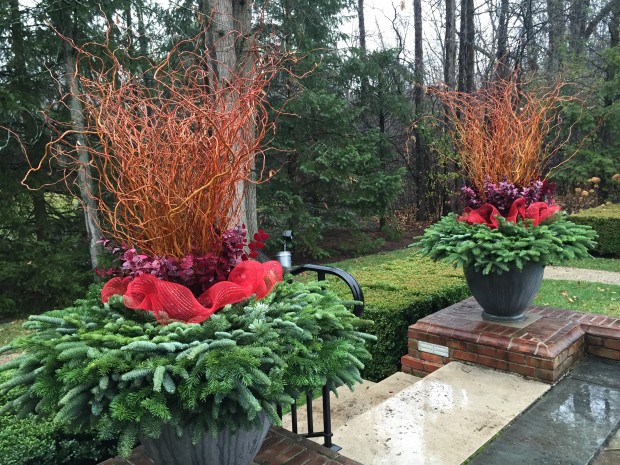 I am not so fond of working in the rain, but today was different. My mind was on another topic entirely. The garden can be so satisfying, on so many different levels. Year after year. Moment after moment. This unusually late November warmth and rain was an experience I would have missed, had I not been out there filling the pots for the winter season to come. Some garden pleasures are so unexpected, simple, and so striking.
I am not so fond of working in the rain, but today was different. My mind was on another topic entirely. The garden can be so satisfying, on so many different levels. Year after year. Moment after moment. This unusually late November warmth and rain was an experience I would have missed, had I not been out there filling the pots for the winter season to come. Some garden pleasures are so unexpected, simple, and so striking.
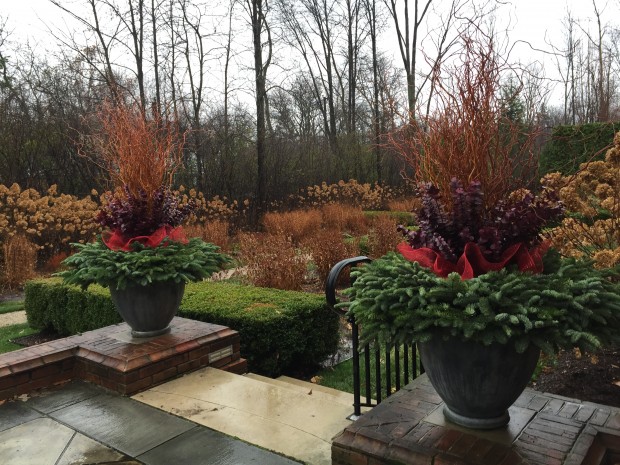 This view out to the late November garden was beautiful. I have been working for these clients for going on 30 years. The holiday/winter pots fit right in. It was a perfectly rain soaked and fabulous November day.
This view out to the late November garden was beautiful. I have been working for these clients for going on 30 years. The holiday/winter pots fit right in. It was a perfectly rain soaked and fabulous November day.
